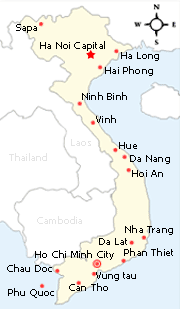|
By Thuong River Bac Giang – the mid-land region well-known for cultural, historical and human beauties and traditional crafts – has seen big changes and developments over the years.
Land of farms and orchards Not only the native land of peasant-turned hero De Tham, the historical Yen The District is also a concentration of cultural, historical and human beauties, and the origin of Thuong River that cuts through Bac Giang Province. Currently, areas well known for fruits like litchi-rich Luc Ngan and other perennial industrial crops are expanding to 45,000 ha together with fields yielding up to VND 50 million (over USD 3,000) per ha annually. Nearly 1,700 farms have mushroomed in the province, bringing about visible changes to the life of Bac Giang locals. It is not rare to see farm owners earning hundreds of million of Vietnamese dong per year. In 1999, Ninh Tuan Khang in Tien Thang Commune, Yen The District, spent his last penny to buy eight hills with a combined area of over 10 ha, and shed sweat to cultivate litchi and rear fish in the farm. His efforts have fruited with an annual income of hundreds of millions of Vietnamese dong per year and a farm of over 20 ha on 19 hills, Khang is now known as one of the richest and the most successful farm owners in the province. His products are seen in markets in various provinces all over the country. In the middle of the hills is a large lake, and in the middle of the lake is a litchi islet. Land of traditional crafts Along Thuong River is also a concentration of traditional crafts typically of Bac Giang Province. Liquor from Van Village, Van Ha Commune, Viet Yen District, processed from the best sticky rice of the North together with tens of medical herbs, has become a must-have offering during festivals and the traditional Lunar New Year. The commune is described as a cradle of Vietnam's ceramics, with the history of the craft being dated back to the 14th century. Not only known for their colours and shapes, ceramic products here are highly resistant to high humidity in the North, and favoured by old peasants as containers of seeds. Only 10 km from Bac Giang City, the rattan-and-bamboo-wickering Tang Tien Village in the commune of the same name takes pride of the history of the craft which dates back 300 years. The craft is so highly efficient that it has driven agriculture into the position of a sideline. Established in 1999, Tang Tien Cooperative has provided jobs to over 5,000 workhands. Every year, millions of household products made from locally available bamboo and rattan are sold in the domestic market and to Japan, Taiwan and the United States.
Bac Giang City The young Bac Giang City is located on the banks of the romantic Thuong River. Right in the suburbs of the City is Bac Giang Ceramics Joint-Stock Company which is trying to restore and preserve the "soul" of Tho Ha ceramics. As busy as a potter, Pham Ninh Quang is described as a director wholly devoted to the craft. On the basis of the remnants of the former Song Thuong Porcelain Factory, Quang and others decided in 2002 to join hands in restoring Tho Ha ceramics, known for its emeralded and emeraldless products. After months of research with help from artisans in Tho Ha Village, they are now successful in exporting their products to foreign countries.
The Dinh Tram Industrial Park has an important role to play in the growth of Bac Giang. By now, the zone has seen 30 investment projects licensed, eight under construction and five operational. Ly Thieu Hung, General Director of Hoa Ha Vietnam Company, a 100-percent Chinese-invested enterprise specialized in the production of plastic utensils and packs, revealed that the decision to select Bac Giang as the investment site was prompted by its advantages in terms of traffic, human resources and incentive policies. Those favourable conditions and the flexible application of the policies have attracted both domestic and foreign investors. The industrial production and services by the City has made a considerable contribution to the visible growth of the province. In the 2001-2005 period, the average annual growth rate of industry is 2.5 times that of 2000. Those changes will help Bac Giang advance further on the way to growth as the human potentials here are so huge. The well-educated young generation will create a strength for Bac Giang people in achieving their major goals and beautifying their historical land.
"Litchi is our hunger-eradicating and poverty-reducing crop for over the past ten years. All the households in the district plant litchi and, as a result, we have been able to bring the rate of the poor households in the district down to 12.9 percent from 43 percent five years ago," said Luong Quang Dong, Deputy Secretary of the Party Committee of Yen The District. Story: Vuong Mo - Photos: Van Chuc, Viet Hung, Trong Chinh
Other news for Saturday 19 September, 2009
View all news for Saturday 19 September, 2009 on one page News for Friday 18 September, 2009
View all news for Friday 18 September, 2009 on one page Recent News
|
















